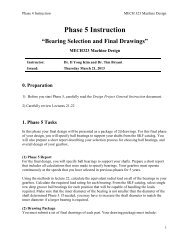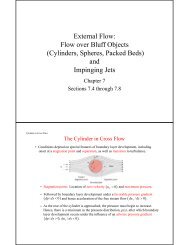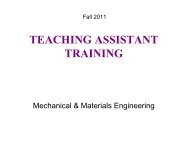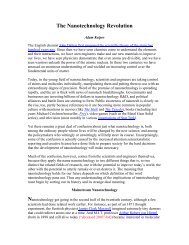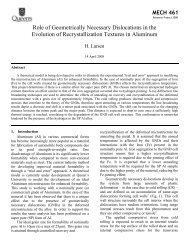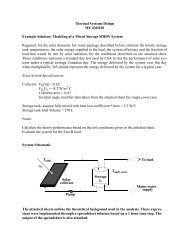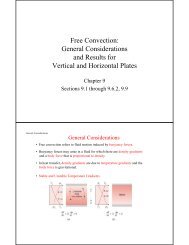Numerical Study of Passive and Active Flow Separation Control ...
Numerical Study of Passive and Active Flow Separation Control ...
Numerical Study of Passive and Active Flow Separation Control ...
You also want an ePaper? Increase the reach of your titles
YUMPU automatically turns print PDFs into web optimized ePapers that Google loves.
flat plate [34, 35]. Other experimental research has also shown that the active control<br />
using deployable vortex generators enhances the momentum mixing <strong>and</strong> energizes the<br />
boundary layer so that the flow separations is delayed [27]. It is also interesting to find<br />
experimentally that the high-frequency deployable micro vortex generator system<br />
(HiMVG) producing an oscillatory flow field at frequencies ranging from 30 to 70 Hz is<br />
very effective in mitigating flow separation on the upper surface <strong>of</strong> a deflected flap [26].<br />
However, the mechanism <strong>of</strong> flow control with active vortex generators is still unclear due<br />
to lack <strong>of</strong> systematic studies.<br />
In cases <strong>of</strong> flow separation, instability <strong>and</strong> laminar-turbulent transition may take place<br />
in the detached free shear layer. It is widely accepted that the instability in the separation<br />
zone is driven by the Kelvin-Helmholtz mechanism if the disturbance level <strong>of</strong> freestream<br />
is low. In this case, transition takes place due to nonlinear breakdown <strong>of</strong> spatially<br />
growing traveling waves in the separated free shear layer [37]. When the shear layer<br />
becomes turbulent, the detached shear layer may reattach to the surface, creating a<br />
separation bubble <strong>and</strong> forming an attached turbulent boundary layer. Yarusevych et al.<br />
[40] studied the boundary layer separation on a NACA0025 airfoil via hot-wire<br />
anemometry <strong>and</strong> surface pressure measurements <strong>and</strong> found the fundamental frequency<br />
associated with flow separation.<br />
<strong>Flow</strong> transition in separation bubbles is a classic topic which has been studied both<br />
theoretically <strong>and</strong> numerically for many years [5]. Among the different approaches used<br />
for the study <strong>of</strong> flow instability, there are the linear stability theory (LST) [9], the<br />
parabolized stability equations (PSE) method [4], <strong>and</strong> direct numerical simulation (DNS)<br />
<strong>and</strong> large eddy simulation (LES). LST is mainly a local analysis with assumption <strong>of</strong><br />
parallel base flow. PSE assumes a steady base flow with no elliptic part. These<br />
assumptions do not apply for the case <strong>of</strong> flow separation <strong>and</strong> transition around an incident<br />
airfoil. With the development <strong>of</strong> computer resources <strong>and</strong> efficient numerical methods,<br />
high resolution <strong>and</strong> high accuracy DNS/LES has become feasible for the study <strong>of</strong><br />
transition in separated flows <strong>and</strong> flow separation control. Early efforts <strong>of</strong> the authors<br />
include the numerical simulations <strong>of</strong> two-dimensional flow separation, three-dimensional<br />
separation <strong>and</strong> transition over a NACA0012 airfoil with 4° angle <strong>of</strong> attack [31,32], flow<br />
4



